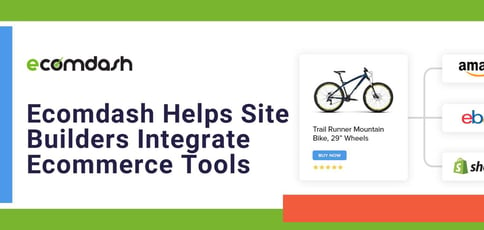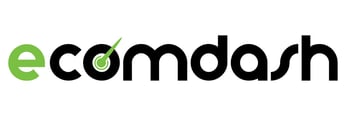
TL; DR: The market for ecommerce tools is still highly competitive even as it consolidates. Ecomdash distinguishes itself from other offerings by providing an all-in-one platform that promotes inventory management, multichannel sales, and simplified shipping and reporting. The company’s tools save time, reduce complexity, and encourage business growth. Ecomdash continues to improve its products with a redesigned user interface that customers will find more intuitive.
In the early days of ecommerce, a handful of major online marketplaces, led by Amazon and eBay, emerged as leaders of the pack. Many smaller retailers relied on selling products in those marketplaces as well as on their own websites. That meant businesses had to manually manage inventory and reconcile different sales reports from each of those sales channels.
Ecomdash emerged to help solve those problems with a unified solution.
“There weren’t many multichannel software options out there that handled all of a retailer’s needs in one platform while also priced affordably,” said Kevin Loomis, Co-Founder of Ecomdash. “Our goal was to offer a platform that made it easier for small ecommerce businesses to grow and sell in more places.”

Ecomdash offers multichannel marketplace solutions to help individuals and small businesses sell their products.
Ecomdash simplifies inventory management across many different platforms. The Ecomdash dashboard connects those channels into a unified backend sales experience. Its integration partners include eBay, Amazon, Walmart, Google, Shopify, and many other popular marketplace platforms. Ecomdash tools allow sellers and site builders to work with a single set of inventory records and sales reports.
The Ecomdash platform also automates drop-shipping and supports a variety of shipping vendors, including tools like ShipStation, although it natively handles direct-to-consumer shipping as well.
Pricing is based on the number of monthly orders, and the company offers a free version for low-volume sellers that still delivers essential core features.
“We wanted to offer these solutions at an affordable price, allowing smaller sellers to compete with the larger players in the ecommerce space without breaking their budget,” Kevin said.
And Ecomdash navigated significant market pressures within its industry to deliver a solution for all.
“I think what attracts and retains customers is the fact that we’ve built the most important tools any small ecommerce owner needs to grow their brand and sell products in the most popular marketplaces,” Kevin said.
The Ecommerce Marketplace Grows More Competitive and Consolidated
In recent years, the ecommerce and inventory management spaces have seen a significant surge of dynamic solutions. Providers experiment with new kinds of value propositions while others consolidate or exit the industry altogether.
Simultaneously, the major platform marketplaces adjust their policies and incorporate new technologies of their own. However, it’s not necessarily the case that size yields success. Some companies serving ecommerce site builders thrive while remaining relatively small. The trajectory, however, is bent toward consolidation.
“The biggest shift in our space is the consolidation of platforms. Ecommerce businesses do not want to log in to so many different places to manage their business operations. So many of our competitors and similar players have consolidated businesses,” Kevin said.
The net result is that fewer platforms overall try to serve as all-in-one ecommerce solutions, although each platform takes a different approach to solving the complexity problem.
One aspect of that phenomenon has been the interplay between shopping carts and the plugin vendors within their orbit. For example, the popular WooCommerce cart — optimized for WordPress — initially offered a basic but robust inventory-and-checkout experience.
Over the years, WooCommerce built more features into the cart, including tools formerly delivered by plugins. Today’s WooCommerce, however, is much more feature-rich. It still supports a plugin ecosystem of its own, but the scope and nature of those extensions have shifted over the years as vendors have sought to do more within a single software vertical. That richness of features adds complexity for site builders working on behalf of the ecommerce sellers.
“Ecommerce is the new way to make money, and it’s a lot more feasible these days to open an online store,” Kevin said. “This increase in popularity has led to a surge in new online retailers, meaning that ecommerce businesses have to differentiate to stay afloat.”
For Ecomdash, staying nimble is key to remaining ahead of the competition. Solution vendors must keep abreast of the dynamic market while trying to differentiate short-term trends from long-term value-adds that help sellers grow. More niche-focused products and marketplaces, and a premium on branding and customization, have prompted fierce competition that often rewards companies that deliver a new idea first.
Integrations are Central to Effective Ecommerce Automation
Feature integration proves a popular market differentiator in such a fast-paced environment. Companies that leverage open data feeds and API calls to interact with many other companies perform well among ecommerce sellers and site builders.
Ecomdash’s deeply integrated ecommerce solutions can handle inventory, multichannel fulfillment, shipping, and warehousing in one interface that covers the scope of the company’s operations. That approach differs from the piecemeal strategy of some platforms, especially open-source or freemium solutions. Many of those offer bare-bones functionality and require plugins — often for a fee — to deliver a minimum viable product.
“Our integrations allow sellers to go to market fast and get their brand in front of millions of customers,” Kevin said. “Selling online is complicated and requires a lot of integrations. Our sellers have those at their fingertips in one place for one price.”

Ecomdash leverages integrations to simplify inventory, sales, and shipping processes across marketplaces.
Kevin said he believes that Ecomdash’s deep integrations lead to significant time savings, which entrepreneurs can channel into business growth.
“Sellers can use Ecomdash to expand to more channels and increase revenue without all the effort and headaches that come with multichannel selling,” he said. “We’ve eliminated many headaches for these sellers, allowing them to focus on the next big thing for their business.”
That could be a small business expanding its own marketplace, building a stronger brand identity, or developing and launching new products. Ecomdash provides them with the freedom to accomplish their goals.
Ecomdash: Streamlining Online Transactions for Businesses
The market for ecommerce tools has grown both more competitive and more consolidated over the years. That competition has resulted in a drive toward differentiation. Players enter and exit this market rapidly, and many toolkits get acquired or rebranded.
One approach to market differentiation lies with diversifying platform integrations. Ecomdash offers an all-in-one service that delivers everything ecommerce sellers need to thrive, thus reducing that seller’s costs and administrative friction.
Although integration is a common theme among market players, different toolkits follow different logic models. Some open-source platforms, for example, rely on a mix of free and paid plugins within a base tool to deliver similar results — potentially at a lower cost but also with higher technical complexity for the seller.
Ecomdash’s integrated suite is responsive to market changes through the company’s deep commitment to customer feedback. In 2013 the company built an MVP version operating on a six-month beta with diverse sellers. Since that beta went live — as the first iteration of Ecomdash — continuous feedback from ecommerce site builders has shaped the company’s product road map.
Next up for Ecomdash is a series of usability enhancements.
“We’re launching a brand new user interface based on feedback from our customers,” Kevin said. “We’ve always had the functionality that sellers needed, but we’ve wanted to make it easier to use. This new launch will come with a much-improved experience for sellers to manage inventory, list products, and fulfill orders.”
And the new user interface will continue to support sellers regardless of their sales volume.
“We love seeing the small ecommerce sellers reach their potential and compete with the big players without paying the big player cost,” Kevin said. “Our sellers can test new markets without the financial risk.”
HostingAdvice.com is a free online resource that offers valuable content and comparison services to users. To keep this resource 100% free, we receive compensation from many of the offers listed on the site. Along with key review factors, this compensation may impact how and where products appear across the site (including, for example, the order in which they appear). HostingAdvice.com does not include the entire universe of available offers. Editorial opinions expressed on the site are strictly our own and are not provided, endorsed, or approved by advertisers.
Our site is committed to publishing independent, accurate content guided by strict editorial guidelines. Before articles and reviews are published on our site, they undergo a thorough review process performed by a team of independent editors and subject-matter experts to ensure the content’s accuracy, timeliness, and impartiality. Our editorial team is separate and independent of our site’s advertisers, and the opinions they express on our site are their own. To read more about our team members and their editorial backgrounds, please visit our site’s About page.



